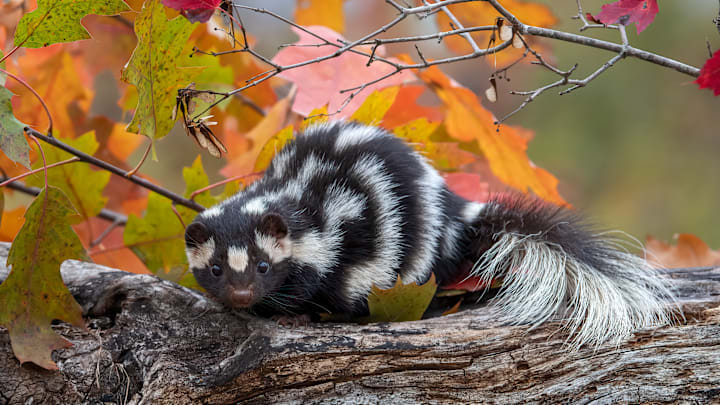Skunks get a bad rap, but there’s amazing chemistry and behavior behind these adorable animals.
- A skunk’s stripes point out its sprayer.
- Skunks do a little warning dance before they spray.
- Skunks evolved their smelly spray because they’re nocturnal.
- A skunk’s spray is powerful stuff.
- They’re in a family named for their best-known attribute.
- Skunk spray is highly flammable.
- You can fight skunk smell with chemicals.
- Skunks are semi-popular pets.
- Some people can’t smell skunks at all.
- Captain Jack Sparrow is loosely based on a skunk.
A skunk’s stripes point out its sprayer.

If it seems like the skunk’s stripes are pointing right to where the noxious spray comes out, that’s because they are. A 2011 study found that animal species that choose fight over flight when faced with a predator often have markings that draw attention to their best weapon. So, while a badger has stripes on his face to highlight his sharp teeth, skunks’ stripes are perfectly positioned to highlight their ability to spray potential threats. The researchers thought this might help keep them safe while conserving their energy and efforts. Better to intimidate a predator away than need to spray him.
Skunks do a little warning dance before they spray.

If the stripes don’t work, a skunk will try to scare off a predator with a complex warning dance. In an effort to avoid having to actually spray their scent—which would render them helpless until they can “reload”—the skunks will run through a series of maneuvers intended to intimidate, including stomping the ground, slapping their tail and, if they’re the smaller spotted skunk, engaging in an awkward handstand-dance.
Skunks evolved their smelly spray because they’re nocturnal.

Why did skunks evolve to rely on a pungent secretion for self-defense while other animals—for example, the meerkat—rely on strength in numbers? A 2014 study found that it has to do with when the potential prey is out and about. Animals that are awake during the day are more vulnerable to attacks from carnivorous birds. They tend to rely on a lookout to scour the skies and call out warnings in the event of danger. Skunks, however, are nocturnal and solitary, putting them more at risk for terrestrial attacks; their ability to spray and stun predators works well in the event of a surprise ambush.
A skunk’s spray is powerful stuff.

Skunks can shoot their sulfur-smelling defense mechanism up to 10 feet out of their anal glands. Aside from the offensive smell that lingers for days (or even weeks), the spray is intensely irritating and can cause temporary blindness in anyone unfortunate enough to get caught in the stream. Even if you’re nowhere near the scene of the spray, you could still suffer the unpleasant consequences: People can detect the scent from up to a mile downwind.
You Might Also Like ...
• The Humane Way to Keep Skunks out of Your Yard
• How Climate Change Shaped This Adorable Skunk’s Evolution
• 10 Surprising Lesser-Known Names for Baby Animals
They’re in a family named for their best-known attribute.

Skunks belong to the family Mephitidae, which means “stink.” They used to be grouped with weasels, otters, badgers, and their relatives in the family Mustelidae—but unlike those animals, which have a duct that secretes scent markings, skunks spray their scent in a controllable stream from nipples in the anal gland. After their DNA was sequenced, scientists learned that skunks derived from a single common ancestor about 30 to 40 million years ago.
Today, Mephitidae contains 10 different species of skunks, which come in different sizes and coloration, and two different species of stink badger, which are the only members of the family not native to the Americas.
Skunk spray is highly flammable.

This is not the point, of course (although how well would that work to fend off predators?), but flammability is a side effect of a chemical weapon comprised of thiols, the sulfur-based compounds also found in garlic and onions.
You can fight skunk smell with chemicals.

In the unlucky event that you get sprayed by a skunk (or, more likely, your dog does), simple soap and water won’t get rid of the stink. Folk wisdom suggests that dousing yourself or your pup in tomato juice will get rid of the scent, but all you’re really doing is masking it—and even then, only to someone who has “olfactory fatigue” from exposure to the skunk spray.
To fully banish the smell, you need to alter the chemical makeup of the thiols, which you can do easily and cheaply with a mixture of baking soda and hydrogen peroxide.
Skunks are semi-popular pets.

Or at least, they have a devoted domestic following. It’s illegal to own skunks in more than 33 states and territories, and each remaining jurisdiction has its own rules and regulations for the types of skunks you can own and the permits you need to purchase one.
Still, the people who manage to own skunks (with their scent glands removed) as pets are adamant about the animal’s appeal. Skunks are smart and curious and exhibit individual personalities, just like a dog or cat.
Some people can’t smell skunks at all.

And not because they have no sense of smell. Specific anosmia, or insensitivity to a particular smell, is actually more common than general anosmia. One in every 1000 people has no ability to detect skunk spray.
Captain Jack Sparrow is loosely based on a skunk.

At least, a cartoon skunk. It’s not clear if this had anything to do with the olfactory effect he was going for, but Johnny Depp once said that he imagined Pirates of the Caribbean’s Captain Jack Sparrow as a blend of Keith Richards and Pepé Le Pew.
Read More About Animals:
A version of this story ran in 2015; it has been updated for 2025.
